Lately I’ve been having a lot of conversations around investment terms with searchers, as well as investors.
About 15 years ago, I interned at a search fund. And, over the last few years, I’ve started to invest in the asset class going direct as well as through funds of search funds.
Investing in search funds is a great way to scratch my entrepreneurial itch, extremely rewarding when a searcher finds success, and can be economically rewarding too.
This post is my attempt to share thoughts on self funded search economics in an effort to contribute to the search fund community, get feedback on my thinking from a wider audience, and of course meet more people who are doing searches/investing and may want to collaborate (please feel free to reach out!).
You can watch a video of me explaining this model here, and download the excel here:

Enterprise Value
The standard finance equation is enterprise value = debt + stock – cash. Enterprise value is how much the company itself is worth. Many times people confuse it with how much the stock is worth and find the “minus cash” part of this really confusing.
So, you can rearrange this equation to make it stock = enterprise value – debt + cash. Make more sense now?
Enterprise value is just how much you’re willing to pay for the company (future cash flows, intellectual property, etc), not the balance sheet (debt and cash).
Most investors and searchers think about the EBITDA multiple of a company on an enterprise value basis because they’ll be buying it on a cash free, debt free basis. It becomes second nature to think about EBITDA multiples and know where a given business should fall given scale, industry, etc.
However, I believe this second nature way of thinking of things can be a massive disadvantage to investors given the way EV and multiples are talked about in our community currently.
Sources of capital, the typical way to calculate enterprise value for self funded searchers
If you’ve ever looked at or put together a teaser for a self funded search deal, you will notice that the deal value is equal to the sum of the sources of capital minus deal fees and cash to the balance sheet.
As a simple example, if there is $4 mm of debt to fund the deal, $1 mm of equity, and $200k of deal fees, the enterprise value = $4 mm + $1 mm – 200k = $4.8 mm.
We’ll use slightly more complex numbers in our example: If a searcher is taking a $3.2 mm SBA loan, $850k seller note, putting in $120k themselves, getting $350k of equity from the seller, a $500k earnout, and $1.2 mm of equity financing minus $350k to the balance sheet and $250k of deal fees, then the enterprise value will be $5.62 mm.
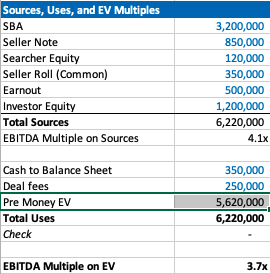
Our example company has $1.5 mm of EBITDA, so the EBITDA multiple is 3.7x. This is a pretty attractive acquisition multiple for a business that meets traditional search criteria (recurring revenues, fragmented competition, high gross margins, low customer concentration, etc).
If you’re seeing a search fund deal for the first time, the headline of “we’re buying a decent company for 3.7x, and replacing a tired owner with a hungry operator” is pretty exciting!
However, if you’re an investor, there is some nuance to this enterprise value number and the true EBITDA multiple you are investing in.
The trick with self funded enterprise value
The security that most self funded search investors get in a deal is participating preferred stock with a paid in kind dividend. This means when there’s an exit, you get your money back before any other equity holder, then get a certain percent of the business, and whatever dividend you’ve been owed in the interim accrues to your principle.
It’s a really favorable security for the investor, and one that is basically impossible to get in VC where straight preferred stock is much more common (no pun intended).
The key terms are what percent of common equity does this security convert into after the originally principal is paid back, and what is the dividend.
The share of common equity the investor group will get typically ranges from 10-50% of the total common stock. The dividend rate is usually 3-15%. The average I’m seeing now is around 30% and 10% for common and dividends respectively.
The strange this about the enterprise value quoted to investors in a teaser/CIM is that it doesn’t change as the percent of common changes, even though this has large implications for how much the common equity is worth and the value investors receive.
For example, I may get a teaser where the sources of investment – cash to balance sheet – deal fees = $3.7 mm for a $1 mm EBITDA company, which would imply a 3.7X EBITDA multiple. Let’s say the searcher is offering investors 30% of the common and a 10% dividend.
Let’s now say that the searcher is having a tough time raising capital and changes their terms to 35% of common and a 12% dividend. Does the effective enterprise value change for investors? I would argue yes, but I would be surprised to see it changed in the CIM/teaser.
This isn’t a knock on searchers or the search fund community. It’s just kind of how things are done, and I think this is mostly because it’s really hard to think about how the enterprise value has changed in this scenario.
However, the natural way of using EBITDA multiples to think about value for a business that is so common in PE/SMB can be extremely misleading for investors here. You may be thinking 3.7X for this type of business is a great deal! But, what if the security you’re buying gets 5% of the common?
If you’re in our world, you may counter this point by saying most searchers will also supply a projected IRR for investors in their CIM. However, IRR is extremely sensitive to growth rate, margin expansion, and terminal value. While the attractiveness of the security will be reflected, it can be greatly overshadowed by lofty expectations.
To get more clarity and have a slightly different mental model on the effective price investors are paying for this business, let’s go back to basics. Enterprise value should be debt + preferred stock + common stock – cash.
We know the values of each of these numbers, except the common. So, the main question here becomes: how much is the common equity worth?
Calculating value of common equity for self funded search funds
Equity value for most search fund deals = preferred equity from investors + the common equity set aside for the searcher and sometimes also advisors, board, seller.
We know that the preferred equity is investing a certain amount for a certain amount of common equity. The rub is that they are also getting a preference that they can take out before any common equity gets proceeds, and they are getting a dividend.
So, the exercise of valuing the common equity comes down to valuing the preference and dividend.
In my mind, there are three approaches:
- The discount rate method where you take the cash flows you’ll get in the future from the pref/dividends and discount them back at the discount rate of your choice. I am using 30% in my model which I believe accurately compensates investors for the risks they are taking in a small, highly leveraged investment run by an unproven operator. If you believe in efficient markets, this number also fits as it mirrors the historical equity returns as reported by the Stanford report, with a slight discount given this asset class has clearly generated excess returns relative to other assets on a risk adjusted basis, hence interest in these opportunities from an expanding universe of investors.
- The second method is to calculate how much money you’d get from your preference and dividends, taking into account that per the Stanford study around 75% of search funds will be able to pay these sums, and then discount these cash flows back at a rate more in line with public equities (7% in my model). This yields a much higher value to the preference/dividend combo, and therefore lowers the implied value of the common equity.
- The last method is to just say nope, there is no value to the preference and dividend. I need them and require them as an investor, but they are a deal breaker for me if they aren’t there, and therefore they don’t exist in my math. This of course makes no logical sense (you need them, but they also have no value?), but I’ve left it in as I think many investors probably actually think this way and it creates a nice upper bound on the enterprise value. Side note, as with obstinate sellers, jerk investors are usually best avoided.
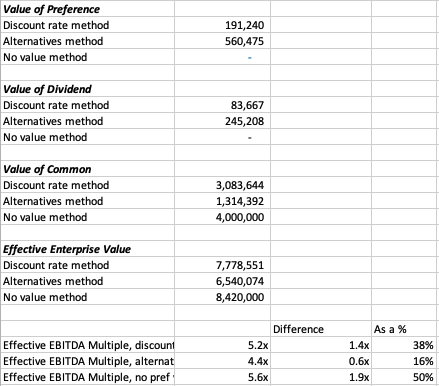
In our example, you can see a breakdown of the preference value, dividend value, and therefore common value and enterprise value for this deal.
In each case, the effective EBITDA multiple moves from 3.7x to something much higher (see the last 3 lines).
There are some simplifying assumptions in the model (no accruing dividend, all paid in last year), and some weird stuff that can happen (if you make the hold time long and the dividend greater than the 7% equity discount rate, the value of the dividend can get really big).
These flaws aside, I think this creates a nice framework to think through what the common is actually worth at close, and therefore what enterprise value investors will be paying in actuality.
It’s worth noting that the whole point of this is to benchmark the value you’re getting relative to market transactions in order to understand where you want to deploy your capital.
This creates a method to translate cash flow or EBITDA multiples of other opportunities on an apples to apples basis (if only there were a magical way to translate the risk associated with each as well!).
Another note, we could calculate the value of the common to be what this asset would trade at market today in a well run auction process minus any obligations (debt, preference, seller financing). However, I think that understates the option value inherent in this equity, a value that is only realized when a new manager takes over with more energy and know how.
There is a finance nerd rational for this. If you plot the value of equity in a leveraged company on a chart, it mirrors the payout of a call option. In both cases, the value of the security increases at a certain inflection point: when the value of equity rises above the strike price in an option, and when the enterprise value of a company rises above the debt level in a levered company.
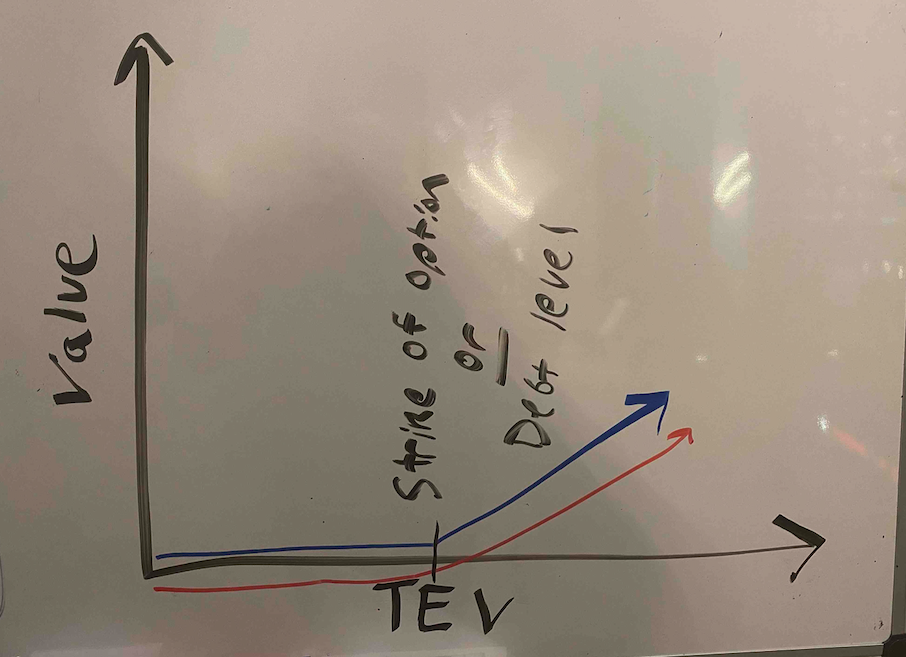
The common equity of a highly levered company can therefore be valued by a similar methodology as the call option: Black Scholes. If you remember back to finance class, increasing volatility will increase the value of an option.
In the search fund case, we’ve (hopefully) increased the (upside) volatility and therefore create more value than simply selling the company today.
A few more thoughts on investor economics
There are a few other ways to think about the economics you get as an investor to best understand if this is the deal for you.
First, you may want to think about how much your investment will be worth day 1. The key lever in this model is what discount this company is being bought for relative to fair market value. For example, the searcher may have proprietary sourced a great company and is buying it for 25% below what it would trade at in a brokered auction.
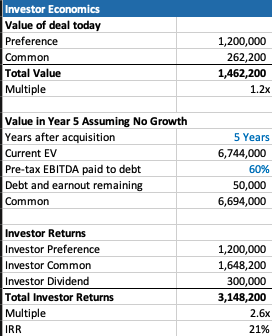
This is very much a “margin of safety” philosophy on things. Same with the calculation on how much you’ll receive in year 5 (after QSBS hits) assuming no growth in the business.
The only problem with each of these calculations is that they never play out in practice. Most companies don’t just stay the same, you’re either in a rising tide or you’re in trouble. And, you’re almost never going to sell in year 1, and definitely not for a slight premium to what it was bought for.
However, if your investment is worth 30% higher day one, and you can make a 20% IRR assuming nothing too crazy happens either way in the business, that’s not a bad place to start. Add in a strong searcher, decent market, some luck, and you’re off to the races.
Thoughts on searcher economics
A lot of this post has considered things from the investor perspective as my main quandary was related to how to create an EBITDA multiple that made sense for investors.
However, the point of this post is not to say searchers are misrepresenting or being unrealistic with their terms. In fact, I think it’s quite logical that self funded searchers capture the massive economic value that they do.
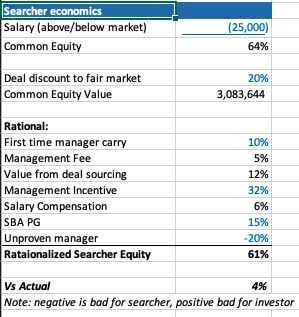
There are many reasons why self funded searchers deserve the lion share of the common equity.
First, they are providing a nice service of giving investors a positive expected value home to park their money with much lower correlation to the market than other asset classes ($1 mm EBITDA companies don’t see lots of multiple contraction/expansion throughout cycles).
Most money managers that fit that criteria are taking a 2/20, of course they also usually have a track record. So, I’ve used a 10% carry in my model, but stuck to 2% annual management fee.
The searcher spent a lot of time, and probably money, finding this company. That’s a lot of value, especially if it’s a below market price. They should be able to capture a lot of the value in finding a below market deal.
The searcher may be taking a below market salary, and needs to get comped like any CEO, with stock options. In my example model I have $1 mm of stock vesting over the hold period, as well as extra comp for taking a below market salary.
Searchers are also usually putting their financial standing at risk by taking a personal guarantee on the bank/SBA loan. This is really tough to put a number on, as is the last line in my framework where searchers are dinged for lack of experience. Like any good model, you need a few lines that you can fudge to make the math work 🙂
What you do think?
I’m shocked that I wrote all this. I was going to type a few paragraphs and a quick excel. However, putting this to paper has been a great exercise for me to sharpen my thinking.
Now I’d like you to help me further. Where do you think this should be changed in this framework? How do you think about things from the investor and/or searcher side?
Feel free to shoot me a note if you have thoughts (even just to tell me I’m being way too academic with this, which I actually agree with).
Lastly, a post like this is really a trap I’m putting on the internet to catch any like minded people in so that we can figure out ways to collaborate now or in the future. So, at the very least, connect with me on LinkedIn 🙂

Great information. Lucky me I discovered your site by accident (stumbleupon).
I have saved as a favorite for later!
Awesome things here. I’m very happy to peer your article.
Thank you a lot and I am looking forward to contact you.
Will you kindly drop me a e-mail?
What i don’t understood is in reality how you are now not really much more neatly-favored than you may be right
now. You are very intelligent. You understand thus significantly with regards to this subject, produced me individually
imagine it from a lot of numerous angles. Its like men and women are not fascinated except it is something
to accomplish with Woman gaga! Your personal stuffs great.
Always take care of it up!
An impressive share! I have just forwarded this onto a coworker who was conducting a little homework
on this. And he in fact ordered me dinner simply because
I found it for him… lol. So let me reword this….
Thank YOU for the meal!! But yeah, thanx for spending the
time to discuss this matter here on your website.
Hi, this weekend is fastidious for me, because this time i am reading this impressive educational post here at
my residence.
You are so interesting! I do not believe
I’ve read a single thing like that before. So great to find
someone with unique thoughts on this subject matter. Seriously..
many thanks for starting this up. This website is something that’s needed on the
web, someone with a little originality!
I have been browsing online more than 4 hours today,
yet I never found any interesting article like yours. It is pretty worth enough
for me. In my opinion, if all website owners and bloggers made good content as you did, the internet
will be a lot more useful than ever before.
Hi! I could have sworn I’ve visited this website before but after going through a few
of the articles I realized it’s new to me. Anyhow, I’m definitely pleased I found it
and I’ll be bookmarking it and checking back frequently!
Hi there! I’m at work browsing your blog from my new iphone 4!
Just wanted to say I love reading through your blog and look forward to all your posts!
Carry on the superb work!
I always spent my half an hour to read this webpage’s content every day along with a cup of coffee.
I am really impressed with your writing skills and also with the
layout on your blog. Is this a paid theme or did you customize it yourself?
Anyway keep up the excellent quality writing, it is rare
to see a nice blog like this one nowadays.
I used to be able to find good information from your blog posts.
always i used to read smaller content which also clear their motive, and that is also happening with this article which I am reading here.
I’ve learn a few just right stuff here. Definitely price bookmarking for
revisiting. I wonder how a lot effort you set to create
this sort of magnificent informative website.
Can you tell us more about this? I’d like to find out some additional information.
Have you ever considered about including a little bit more than just your articles?
I mean, what you say is fundamental and all. But imagine if
you added some great images or videos to give your posts more, “pop”!
Your content is excellent but with pics and videos, this blog could certainly be one of the best in its
field. Excellent blog!
Hi there excellent website! Does running a blog such as
this require a large amount of work? I’ve absolutely no knowledge of
programming but I had been hoping to start my own blog in the near future.
Anyway, should you have any suggestions or techniques for new blog owners please share.
I understand this is off topic nevertheless I just wanted to ask.
Thanks!
Please let me know if you’re looking for a article author for your
blog. You have some really great posts and I believe I would be
a good asset. If you ever want to take some of the load off, I’d love to write some material for your blog in exchange for a link back to mine.
Please shoot me an e-mail if interested. Many thanks!
Hi, for all time i used to check webpage posts here in the early hours in the dawn, for the reason that i like to learn more
and more.
Howdy! I could have sworn I’ve been to this blog before but after reading
through some of the post I realized it’s new to me.
Anyways, I’m definitely glad I found it and I’ll be bookmarking and checking back often!
We’re a group of volunteers and opening a new scheme in our
community. Your web site offered us with valuable info to work on. You have done an impressive job and
our entire community will be thankful to you.
Good post however , I was wondering if you could write a litte more on this topic?
I’d be very thankful if you could elaborate a little bit more.
Kudos!
Nice blog here! Also your website loads up fast!
What web host are you using? Can I get your affiliate link to your host?
I wish my site loaded up as quickly as yours lol
Hey there! I know this is somewhat off topic but I was wondering if you knew where I could find a captcha plugin for my comment form?
I’m using the same blog platform as yours and I’m having
trouble finding one? Thanks a lot!
Why users still use to read news papers when in this technological
globe everything is accessible on web?
Thanks for sharing your thoughts. I truly appreciate your efforts and I will be waiting for your further post thanks once again.
Saved as a favorite, I love your website!
Hi there to all, how is the whole thing, I think every
one is getting more from this site, and your views are pleasant in favor of new visitors.
You could definitely see your expertise within the work you write.
The sector hopes for even more passionate writers like
you who are not afraid to say how they believe. All the time follow
your heart.
Hi! Someone in my Facebook group shared this website with us so I came to check it out.
I’m definitely enjoying the information. I’m bookmarking and will be tweeting this to my
followers! Exceptional blog and terrific style and design.
What’s up mates, how is the whole thing, and what you want to say concerning this article, in my view its genuinely amazing
in support of me.
Heya i’m for the first time here. I came across this board and I in finding
It really helpful & it helped me out much. I am hoping to provide one thing again and help others like you aided
me.
Hi there, just became alert to your blog through Google, and found that it’s truly informative.
I am gonna watch out for brussels. I will appreciate
if you continue this in future. A lot of people will be benefited from your writing.
Cheers!
It’s really very difficult in this busy life to listen news on TV,
therefore I only use web for that purpose, and get the latest information.
The other day, while I was at work, my cousin stole my iPad and tested to
see if it can survive a 25 foot drop, just so she can be a youtube sensation. My apple ipad is now broken and
she has 83 views. I know this is totally off topic but I had to share it with someone!
Post writing is also a fun, if you know after that you can write otherwise it is complex to write.
Amazing things here. I am very happy to peer your article.
Thank you so much and I’m having a look ahead to touch you.
Will you please drop me a mail?
Very good article. I definitely love this site. Keep it
up!
Hi Dear, are you genuinely visiting this web site daily, if so then you will without doubt
take nice knowledge.
Way cool! Some very valid points! I appreciate you penning
this write-up and also the rest of the site is also really good.
Thanks a lot for sharing this with all of us
you actually understand what you are speaking
about! Bookmarked. Kindly additionally seek advice from my website =).
We will have a link alternate arrangement between us
I think the admin of this site is actually working
hard in favor of his website, for the reason that here every information is quality based stuff.
Remarkable! Its really amazing post, I have got much clear idea about from this piece of writing.
Pretty portion of content. I simply stumbled upon your site and in accession capital to claim that
I get in fact loved account your weblog posts. Any way I’ll be subscribing on your feeds or even I fulfillment you get entry to persistently rapidly.
I know this web page gives quality depending articles or reviews and other stuff, is there any other website which presents these kinds
of data in quality?
Thanks for ones marvelous posting! I truly enjoyed reading it,
you could be a great author. I will be sure to bookmark your blog and
definitely will come back in the foreseeable future.
I want to encourage continue your great posts, have a nice weekend!
Hello there! This is my first visit to your blog!
We are a collection of volunteers and starting a new initiative in a community in the
same niche. Your blog provided us valuable information to work
on. You have done a marvellous job!
Appreciate this post. Will try it out.
Heya i am for the first time here. I found this board and I
in finding It really helpful & it helped me out much. I hope to present something back and help others like
you helped me.
I was more than happy to uncover this web site. I wanted to thank you for ones time for this
wonderful read!! I definitely enjoyed every little bit of it and i also have you bookmarked to check out new stuff on your website.